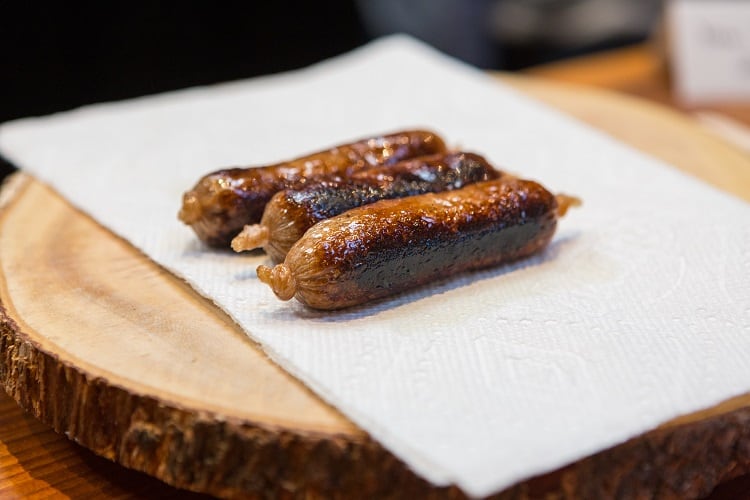Since cultivated meat first emerged in the late 2010s, the market has grown exponentially. Between 2016 and 2019, £144.4m was invested into the sector, but in 2020 and 2021, the cultivated meat market saw £1,765.3m in deals. Since 2016, Oghma Partners predicts more than £2.6bn has been invested into the cultivated meat sector.
Over the period, Oghma Partners identified a total of 346 transactions. However, some companies have received the lion’s share of the value of such investments. 46.9% of the value of the deals were made up of just five brands: UPSIDE Foods, Believer Meats, Wildtype, Mosa and Aleph Farms. 21.5% was taken up by UPSIDE Foods.
Decline in deals
In the first eight months of 2023, the cultivated meat market has seen 27 transactions. The have declined in volume by 44.9% compared with the same period in 2022. The report predicts that the steady rise in the value of deals since 2019, too, will slow down in 2023 ‘due to macroeconomic conditions.’
According to Mark Lynch, Partner at Oghma Partners, the slowdown is general, not specific to cultivated meat. “We have seen an across the board reduction in investment activity in early stage businesses due to the changing interest rate and macro-economic environment,” he told FoodNavigator.

Carlotte Lucas, Senior Corporate Engagement Manager at the Good Food Institute (GFI) Europe, agreed. “With global venture capital funding declining by 42% across all sectors in the first three quarters of 2023 compared to the same period last year, it’s no surprise that the cultivated meat sector has seen a slowing volume of deals as increasingly risk-averse fund managers seek to consolidate investments,” she told FoodNavigator.
Furthermore, the cultivated meat market is still very nascent. It is only commercially available in a single country, Singapore, and has regulatory approval only in Singapore and the US (although Israel’s Aleph Farms has submitted its products for regulatory approval in Switzerland and the UK).
“For the industry to succeed,” Oghma Partners’ Lynch told us, “there will need to be a ramping up of investment to get it to commercialisation – right now I think we are still at ‘proof of concept’ phase.”
Affordability is also one of the key aspects that could restrict the growth of cultivated meat. This is something that needs to be worked on. “Currently cultivated meat is expensive relative to animal alternatives,” Lynch told us. “Sales will initially have to be subsidised until critical mass drives costs down to an acceptable level – this is one area where investment is needed as we have seen in the plant-based space for example.”
According to the report, 48.3% of deals in the space were seed and early VC. However, 34.8% were later VC, which, the report suggested, shows growing investor confidence in the sector.
Government investment and regulation
Because of its novelty, cultivated meat is an area where governments are inexorably intertwined with private business. On the one hand, countries such as the UK, Israel, the Netherlands and China have announced extensive public programmes investing in cultivated meat development. However, on the other, regulations around the sector must be defined before cultivated meat can be commercially available on a wider scale.

The investment comes, suggested GFI’s Lucas, because of the climate mitigation opportunities cultivated meat presents. “Governments are becoming increasingly aware of cultivated meat’s potential to cut climate emissions, reduce reliance on imports and create future-proof jobs,” she told us.
“It’s an encouraging sign that public investments are increasing, but we need to see far more government funding to help sustain private sector confidence and enable the open-access research that will accelerate progress towards lower-cost, larger-scale production.”
However, on the other side of the coin, the regulatory landscape around cultivated meat is still shifting. Not all nations take Singapore’s open-minded approach towards it. For example, the Italian government recently backed a bill that would ban lab-produced meat there.
“As Italian politicians prepare to vote on banning cultivated meat, while countries like the Netherlands invest, the EU must develop a coherent strategy to deliver the certainty companies and researchers need to make progress,” Lucas suggested.
The US dominates the market so far, with 83 of the 346 deals being made up entirely of US-based investors, according to the report. According to Oghma Partners’ Lynch, the US’s more relaxed approach to regulation compared to the EU could hamper the latter’s growth in the sector.
“The EU tends to take a more cautious approach to food regulations than the US,” he told us. “For the EU to compete with the US then there will have to be a proper legislative environment created for its development which is currently lacking.”
Cultivated meat in poorer countries
According to the report, nations with ‘poorer domestic agriculture’ could benefit from the technology to produce cultivated meat.
“Ultimately cell-based meat offers a great opportunity to reduce greenhouse gases and to potentially release land for other uses,” Oghma Partners’ Lynch told us. “Which nations benefit from this opportunity will depend on cultivated meat-friendly legislation and attracting either domestic or international investors by an investor friendly environment.”
GFI’s Lucas agreed. “Cultivated meat requires up to 90% less land, is up to 5.8 times more efficient at converting feed into meat, and can be made in any part of the world, so can help boost food security even in land-constrained environments.
“The key to ensuring this new way of making meat is accessible globally is for governments to invest in open-access research, helping to bring prices down and meaning the technology is open-source and available for anyone to use. Governments and businesses should also fund work to develop cultivated meat products that suit the taste of local communities and fit into existing food cultures.”




